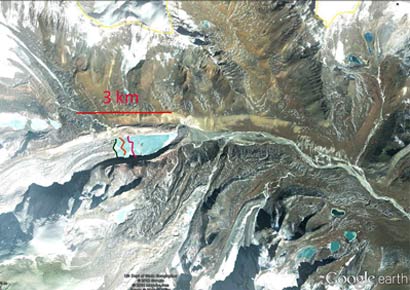 |
|
The
South Lhonak Glacier, which drains east from Lhonak Peak into Sikkim from the
Nepal-Sikkim border, has developed a lake whose outburst probability is very
high at 42% and peak discharge estimated at 586
m3/s.
|
A satellite-based study has indicated that a huge glacial lake has formed
atop the Himalayas in Sikkim with a "very high" potential for it to burst and
create devastation downstream.
Analysis of satellite data has revealed that the lake has formed at the snout
of South Lhonak glacier, that is about 7,000 meters high on the mountain in the
northeastern state. The lake, bounded only by loose soil and debris, could cause
havoc downstream if it ruptures, according to scientists at the National Remote
Sensing Centre (NRSC) in Hyderabad.
In a report published in the latest issue of the journal
Current
Science, NRSC researchers Babu Govindha Raj and co-workers say the glacial
lake is about 630 meters wide and 20 meters deep.
It covers an area of 98.7 hectares and contains 19.7 billion liters of water.
A sudden outburst "can create devastating floods downstream," they warn, adding
that the probability of this happening "is very high". They, however, note this
is only their preliminary assessment and more field studies are required to
confirm the hazardous potential of this high altitude lake.
Data from the American Landsat, CORONA and Terra satellites besides imageries
from India's own Resourcesat-1 satellite were used to estimate the size of the
shrinking Lhonak glacier and the growth of the glacial lake at different times
between 1962 and 2008.
Based on this study the scientists estimate that the Lhonak glacier had
receded 1.9 km between 1962 and 2008. The glacial lake that was initially a
small body of water in 1962 grew in size with accumulation of melt water. The
NRSC scientists say that the lake is still attached to the snout of the glacier
but is expanding in area due to the glacier retreat.
"The rate of growth of the lake indicates possible developments of the hazard
situation," the report says.
As Himalayan glaciers are retreating fast, it is necessary to make an
inventory of glacial lakes and set up an early warning system for lake outburst
floods in vulnerable areas, they say.

No comments:
Post a Comment